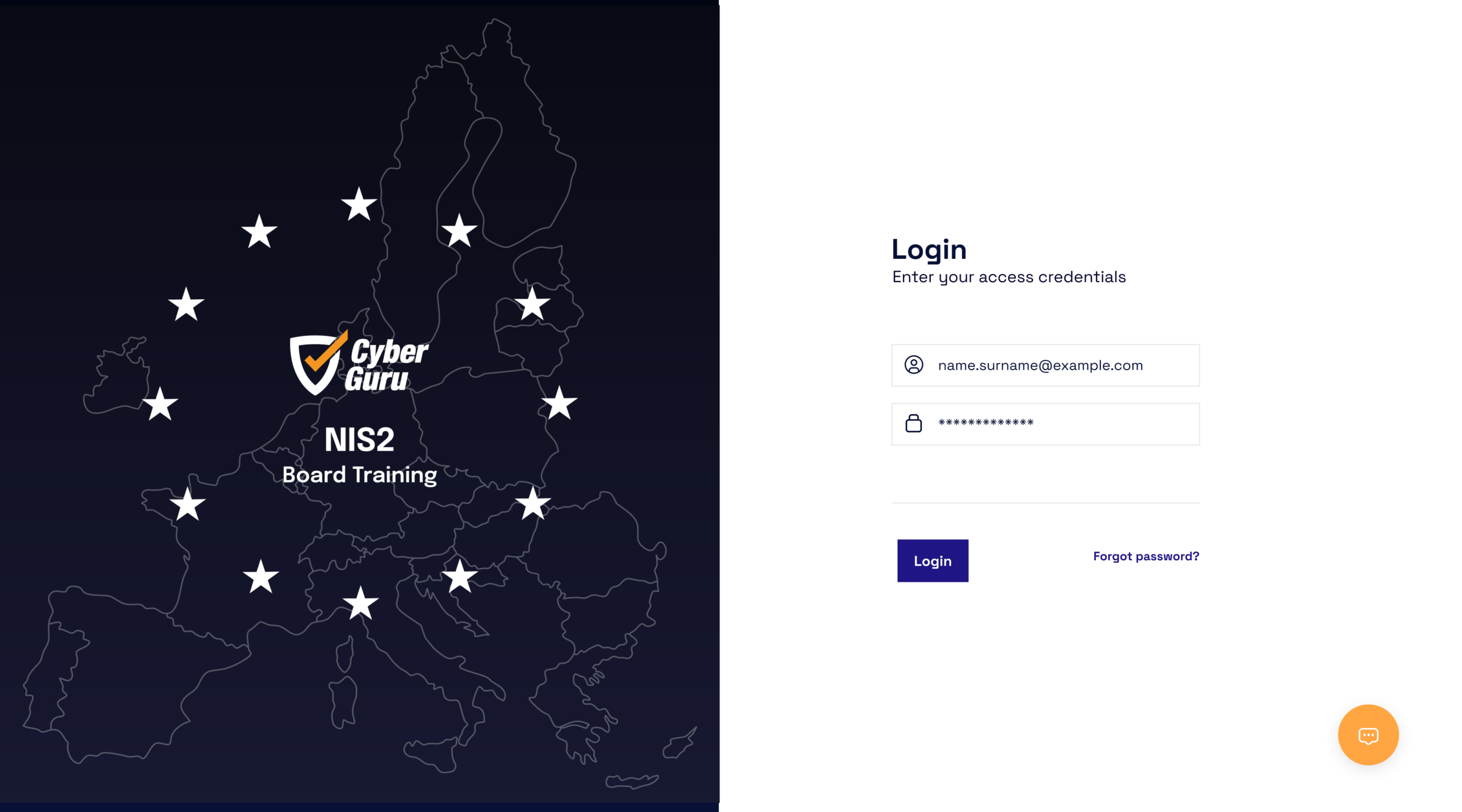Board Training NIS2
Level 2
NIS2 Board Training / Level 2
Cyber Guru NIS2
Level II of the NIS2 course addresses digital protection challenges by combining governance, advanced technologies and cyber risk awareness. It aims to provide skills to manage cyber threats through governance strategies, use of Artificial Intelligence, and real-world case analysis with a focus on regulations, risk management, and attack techniques to strengthen business resilience. The goal of the course is to increase security awareness and create an effective security culture against evolving cyber threats.
SECTION I
INTEGRATED CYBER SECURITY
3 Lessons
SECTION II
FROM GOVERNANCE TO AI
3 Lessons
SECTION III
CYBER CASES.
4 Lessons
SECTION IV
SECURITY AWARENESS
6 Lessons
SECTION I – INTEGRATED CYBER SECURITY
LESSON 1 – SUPPLY CHAIN SECURITY
Supply chain security is crucial in cyber risk, as emphasized by NIS2 and security frameworks. Supply chain management requires cybersecurity involvement already in partner selection and a strategy that includes pre-testing, vulnerability analysis, and penetration testing prior to integration. Contracts and NDAs must formalize security requirements and provide for ongoing audits.
SECTION I – INTEGRATED CYBER SECURITY
LESSON 2 – THE DIGITAL IDENTITY
Digital Identity is the new security perimeter for organizations, and the Zero Trust approach ensures secure access by authenticating and authorizing every operation according to the principles of least privilege and need-to-know, preventing risks related to technology layering and excessive permissions. Key tools such as Directory Service for identity management, IAM for application permissions, PAM for administrative access, and Conditional Access.
SECTION I – INTEGRATED CYBER SECURITY
LESSON 3 – SECURITY BY DESIGN
The principle of Security by Design requires that security be integrated from the design phase of software, infrastructure and processes, safeguarding confidentiality, integrity, availability and resilience of data. This rigorous and disciplined approach is essential to reduce cyber risks and the cost of subsequent interventions, applying to every phase from conception to delivery, including context and risk analysis, definition of security requirements, and treatment and acceptance of residual risk.
SECTION II – FROM GOVERNANCE TO AI
LESSON 1 – THE PEOPLE.
Managing cyber risk requires not only technological solutions, but also governance and people involvement. The Cybersecurity Governance Framework, consisting of guidelines, policies and procedures, organizes rules to protect data and infrastructure. However, inappropriate behavior can undermine security investments.
SECTION II – FROM GOVERNANCE TO AI
LESSON 2 – THE CLOUD
In the past, cloud strategy aimed to reduce costs by divesting data centers, but technological and economic complexity has made this approach obsolete. Today, with digital transformation, the cloud is indispensable to ensure speed and flexibility. Companies are adopting a “Cloud Economy” based on modular and reusable components, adapting to time to market and designing agile and temporary services.
SECTION II – FROM GOVERNANCE TO AI
LESSON 3 – AI AND CYBERSECURITY
Artificial Intelligence is revolutionizing cybersecurity, with Machine Learning and language modeling (LLM) tools that analyze large volumes of data, reduce false positives, and support activities such as security control selection, policy writing, and regulatory navigation. AI agents can complement or replace first-level teams in Security Operation Centers, accelerating threat response, and improve Threat Intelligence to prevent attacks.
SECTION III – CYBER CASES
LESSON 1 – DEEPFAKE AND MANIPULATION
An ultra-realistic deepfake of the CEO appears in a video, announcing a fake acquisition. The company’s stock plummets and the Board is forced to take swift action.
SECTION III – CYBER CASES
LESSON 2 – ATTACK ON PERSONAL DEVICES
A board member accesses the corporate network from his outdated personal tablet. Malware infiltrates systems, allowing hackers to spy on strategic meetings.
SECTION III – CYBER CASES
LESSON 3 – TARGETED PHISHING
A Board member receives a well-structured email, apparently from a strategic partner, with an infected attachment. Upon opening the file, hackers gain access to confidential Board documents.
SECTION III – CYBER CASES
LESSON 4 – INSIDER THREAT
A senior executive begins to behave suspiciously. Shortly thereafter, he is found to have exfiltrated sensitive data on business strategies and sold it to a competitor or hostile state actor. The company suffers serious competitive damage and risks legal repercussions.
SECTION IV – SECURITY AWARENESS
LESSON 1 – ADVANCED SPEAR PHISHING
SECTION IV – SECURITY AWARENESS
LESSON 2 – AI AND DATA PROTECTION
SECTION IV – SECURITY AWARENESS
LESSON 3 – SOCIAL ENGINEERING
SECTION IV – SECURITY AWARENESS
LESSON 4 – BRING YOUR OWN DEVICE (BYOD)
SECTION IV – SECURITY AWARENESS
LESSON 5 – AUTHENTICATION
Authentication systems protect access to networks, data and business applications, ensuring that only authorized users can operate. Traditional password-based methods are increasingly vulnerable to phishing, brute force and credential stuffing, making a more secure approach necessary.
SECTION IV – SECURITY AWARENESS
LESSON 6 – ADVERSARIAL ATTACK

Would you like to know more?




